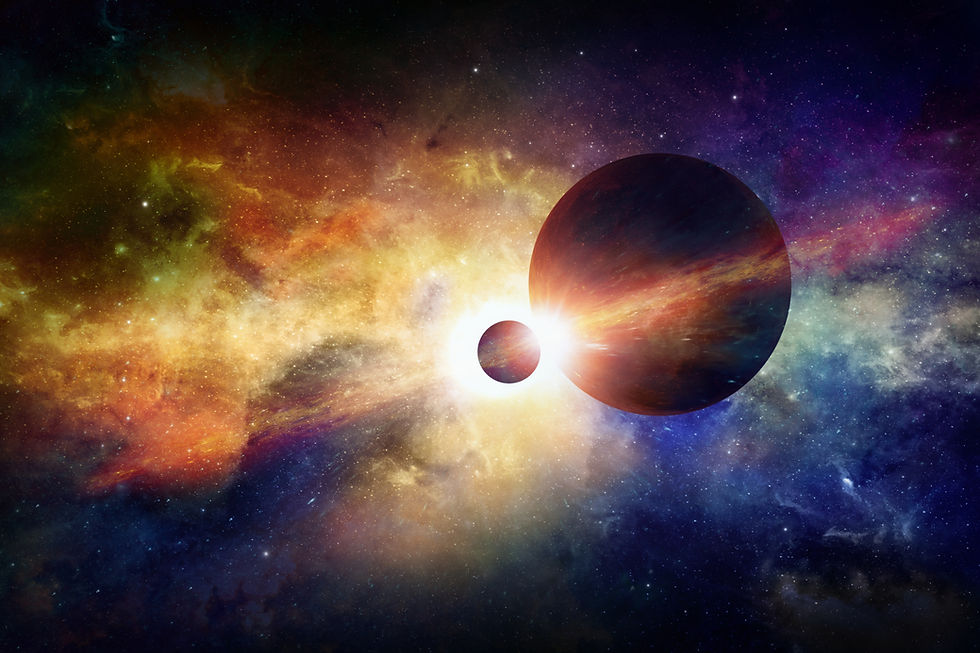Part Two: The Vedic Vision — Karma, Time, and the Soul’s Return to Center
- Cel 🌙

- Apr 2
- 6 min read
Updated: Apr 7
While the Abrahamic imagination often casts the cosmos in terms of separation—light from dark, Creator from creation—the Vedic worldview begins not with a fall, but with a cycle. There is no exile from the garden. There is only return.
In this second part, we turn eastward—to a cosmology that views time not as a straight line, but as a wheel; life not as a one-time gift or test, but as a series of unfoldings, returnings, refinements. In the Vedic vision, the soul does not simply obey or rebel—it remembers. It reconfigures. It returns, again and again, through births and deaths, through choices, longings, impressions, and prayers that stretch across lifetimes like music played in slow motion.
Where Abrahamic theology fears the stars might rival the authority of the divine, Vedic philosophy invites us to see the stars as part of divine intelligence itself. They are not gods, but expressions. Not masters, but mirrors. Not mechanical fates, but luminous signifiers of karma, dharma, and inner becoming. Astrology in this context—Jyotish, or “the science of light”—is not an act of rebellion. It is an act of listening.
If the Western chart is a sentence, the Vedic chart is a mantra: repeating, spiraling, activating. It’s not written in stone, but in rhythm. The rhythm of breath, of memory, of karma returning like waves on an eternal shore.
The concept of time in the Vedic tradition is not linear, but mythic. It is not counted—it is embodied. Known as Kala, time is not merely a measurement, but a force, a god, a sculptor of soul and matter. Governed by Yama, the god of death, time is not a thief, but a teacher. It does not move forward—it pulses. It spirals. It devours and regenerates.
In the Vedic imagination, the past is not dead—it’s dormant. The future is not a blank page—it’s a coiled snake, curled around the conditions of the present. The soul moves through time not in a straight path toward salvation or judgment, but in recursive loops: samsara, the wheel of birth and death, desire and dissolution.
This is why astrology in this context cannot be fatalistic. It is not a machine. It is not a verdict. It is a field of memory—a karmic echo chamber that reflects the vibrations of past choices and the possibilities of present consciousness. The chart does not show “what will happen.” It shows what is available. It is not prophecy. It is pattern.
To understand karma in this cosmology is to understand the difference between punishment and momentum.
Karma is not what we deserve—it is what we carry. It is not judgment—it is inertia. The Vedic birth chart shows these karmic imprints, not as accusations, but as clues. Clues to what has been left unresolved. Clues to what is seeking integration. Karma is less a system of rewards and penalties, and more a choreography of cause and effect across time. It moves like weather through lifetimes, attaching itself not to morality, but to memory.
Here, the north and south nodes of the Moon—are cosmic mnemonic devices. They are not planets, but shadows. They do not shine—they bend light. They mark where the soul is hungry, and where it is tired. North node is desire unfulfilled. South Node is wisdom unprocessed. They represent the great karmic tension between grasping and letting go, between incarnation and transcendence.
To work with a chart is to listen to these tensions. The goal is not to eliminate karma, but to recognize it. To hold it with awareness, not attachment. To act with clarity, not compulsion. In this sense, the astrologer is not a prophet, but a witness. Not a judge, but a mirror-holder. A cartographer of the soul’s current terrain.
Planets in Jyotish are not abstract symbols—they are deities, or rather, embodied principles of divine order. They are not impersonal forces. They are mythic intelligences with memory, flavor, and instruction.
Saturn is not merely a source of delay and hardship—he is the slow teacher, the one who makes you earn everything you keep. He is gravity, responsibility, consequence. His lessons are heavy not because he wants to punish, but because he wants to prepare. In Saturn’s world, shortcuts are illusions and mastery is slow. He doesn’t block your path. He checks your readiness.
Venus is not simply the planet of pleasure. It is the teacher of beings called "Asuras", although literally translated would equate to demons in English, but are meant to be beings who are indulged in material and physical pleasure. Venus then becomes the one who offers refinement through sensual truth. Where Jupiter gives scripture, Venus gives experience. It teaches through longing, beauty, eroticism, and emotional saturation. She is not romantic in the modern sense. She is sacredly aesthetic, devoted to the art of being.
The nodes of the moon again, are not merely headless disruptors. They are the evolutionary push and pull of desire and detachment. The North Node swells the ego in order to stretch the soul. The South Node dissolves the ego in order to expose the spirit.
This planetary pantheon reveals that astrology in the Vedic context is not a system of technicalities—it is a divine theatre, a field of encoded memory and archetype. Each planet becomes a kind of guru, guiding us through a specific domain of experience, offering us initiation through joy or through friction.
The chart, then, is a memory map. Not just of past lives, but of samskaras—impressions left on the soul by prior actions. These impressions become tendencies. These tendencies become patterns. And patterns become our unconscious scripts. The chart reflects these scripts not to trap us in them, but to make them legible. To make the unconscious visible. To show the choreography between fate and free will.
Karma, as pattern, meets dharma as potential. And in that intersection, astrology becomes a mirror not just of who we’ve been, but of what we might now become.
To say this another way: astrology, in the Vedic frame, is not the study of “what will happen.” It is the study of what wants to happen through you, if you align with the soul’s deeper thread.
It does not predict events. It invites readiness.
It does not hand you a script. It hands you a vibration.
The birth chart becomes a vibrational signature—a kind of cosmic music score, written at the moment of incarnation. To read a chart is to listen. To play your chart well is not to follow the notes rigidly, but to learn how to improvise in tune with your karma.
This is why Jyotish means “science of light.” The light it speaks of is not external—it is the light of consciousness shining on karmic shadow. It is the light of awareness that makes change possible.
There is a reason why astrology has long been part of Vedic ritual, temple life, and Ayurvedic medicine. Because it was never meant to exist outside of a sacred ecosystem. Jyotish is one of the six Vedangas—the limbs of the Veda. It is not separate from spirituality. It is a tool for right timing. A lens for dharmic alignment. A method of cosmic listening.
The astrologer, in this view, is a listener—not a controller. A student of rhythm, not a master of fate.
This rhythm is not mechanical. It is musical. And just like music, it can only be felt by slowing down. The chart invites us to feel the pauses, the rests, the notes we keep playing without knowing why. It offers us a score we didn’t know we were following, and asks, gently, “Do you want to keep playing this one? Or do you want to shift the key?”
Moksha—liberation—is the end of rebirth. But it is not escape. It is not disembodiment. It is the state of non-attachment to outcome, non-identification with the karmic self. It is the freedom to act without grasping. To love without clinging. To serve without needing credit.
Astrology does not give us moksha. But it may point toward the friction that still binds us. It shows us what we are clinging to. It shows us where the loop hasn’t closed yet.
The paradox of liberation is that it often comes through surrender, not strategy. And even that surrender may be encoded in your chart—not because it was forced, but because the soul asked for it.
Here, the path to liberation is not through mastering the chart, but through seeing it as one language among many in the divine symphony. Not a cage. Not even a compass. Just a song the soul plays until it no longer needs sound to remember its source.
In closing, we might say this:
The Abrahamic traditions taught us to look up and ask, “Who made this?”
The Vedic tradition invites us to look inward and ask, “Who remembers this?”
Where one tradition centers sin and grace, another centers karma and surrender. Where one seeks salvation, the other seeks liberation. And somewhere in between, the stars remain—neither gods nor tyrants, but timekeepers of the soul’s unfolding.
Astrology, in this deeper vision, is not rebellion. It is remembrance. Not the fear of fate. But the poetry of pattern. As Krishna states in the Bhagavad Gita,
“As a person sheds worn-out garments and wears new ones, so the soul casts off worn-out bodies and enters into others.” —Bhagavad Gita 2.22
This verse elegantly supports the Vedic understanding of reincarnation, karma, and the soul’s continuous return. It’s still present in the body of the piece, woven into the paragraph that begins:
The Vedas teach that the soul is eternal, that death is not an end, and that time is a teacher…
However, even in a karmically mapped life, there is a final movement toward grace and surrender that transcends form.



Comments